 Royal Palace of Phnom Penh (29 September, 2002)
Royal Palace of Phnom Penh (29 September, 2002)
Phnom Penh is the capital and biggest city in Cambodia. It is located on the banks of the Mekong River, near the confluence with the Tonlé Sap River and Bassac River. The city covers an area of 678.46 sq km (262 sq mi) and has a population of 2.2 million people.
Phnom Penh is within the Cambodia standard time zone, which is 7 hours ahead of Coordinated Universal Time (UTC+7). The local phone area code here is +855 (023). The city comprises 8 districts known as khans.
Phnom Penh is the cultural, commercial as well as political capital of Cambodia. Founded in the 14th century, Phnom Penh became the capital of Cambodia in 1866 under the reign of King Norodom. The city is located by the banks of the Sap River, where it meets the Mekong River and the Bassac River. The Sap flows from Tonle Sap, except in summer, when the water reverses its flow.
Phnom Penh is the focus of four highways radiating out to the provinces. The roads in Phnom Penh itself follow a numbered grid system. Roads the run north-south are odd numbered. The number increases westward. Roads running east-west have even numbers.
Major Tourist Attractions of Phnom Penh
- Royal Palace of Phnom Penh
This is a must-see if you wish to view Cambodian architecture at its finest, although I must say that it borrows heavily from Thai architecture, and is nowhere as ornate as the Grand Palace in Bangkok. The Royal Palace is located in front of an open square overlooking the Sap River. Its most prominent building as seen from the outside is the Chan Chaya Pavilion. Make sure you are decently dressed to enter the Royal Palace - I made the mistake of coming in a sleeveless tee, and had to find a shirt to cover up.
- National Museum of Cambodia
This is where you can find the best examples of Angkor sculptures. The museum is not air conditioned. Nevertheless, if you are interested in Angkor, this is where to go. The National Museum is located north of the Royal Palace, and is possible to approach either one on foot from the other. Photography is not allow inside.
- Tuol Sleng Genocide Museum
This is the high school that became S21, the most notorious prisons in Cambodia. Over 17,000 people held at S21 met a dead end, literally. From here, they were parcelled off to the extermination camp at Choeung Ek. Today, this high school has become a museum to commemorate those who died in the Khmer civil war. This place is only for those with an interest in learning about the brutality of the Khmer Rouge. Tuol Sleng is within the city of Phnom Penh. You can get here on a tuk tuk or join a day tour.
- Choeung Ek Killing Fields
This is where the prisoners from S21 were taken to be executed. Many were simply bludgeoned to death to avoid wasting bullets. They were buried in shallow graves. Today, visitors walking through the killing fields of Choeung Ek can still come across broken human bones and teeth in the ground. There is a memorial stupa housing over 7280 skulls of the dead, neatly arranged by gender and age. This is definitely not a place for the faint-hearted, and makes human life appear so dispensible. Choeung Ek is a short distance outside town; you should arrange with a tuk tuk to take you here, or join a day tour.
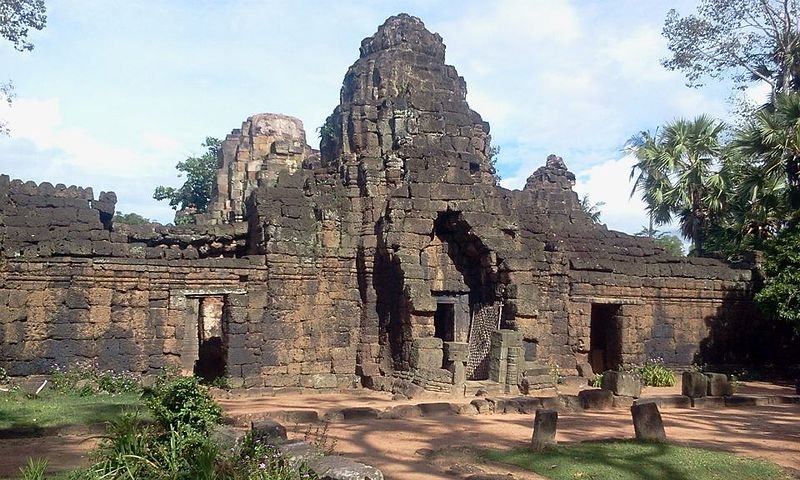 Tonle Bati, a temple ruin located south of Phnom Penh
Tonle Bati, a temple ruin located south of Phnom PenhSource: https://commons.wikimedia.org/wiki/File:Tonle_Bati_temple.jpg
Author: Anilakeo

Author: Anilakeo

Other Sights in Phnom Penh
- Wat Ounalom
This may be Phnom Penh's most important wat, but it is not really spectacular. Wat Ounalom is the headquaters of Cambodia's Buddhist patriachate. It was founded in 1443 and comprises 44 structures. During the Khmer Rouge era, much of the temple complex was destroyed, including its extensive library, which will take time to replenish.
- Wat Phnom
Phnom Penh got its name from this temple. It stands at the top of a 27m-high hillock, with a staircase flanked on both sides by undulating nagas. The original pagoda at Wat Phnom was erected in 1373 to house four Buddha statues which washed ashore near here. A woman named Madam Penh recovered the statues from the Sap River. Phnom Penh, which means "Penh's Hill" was named after this woman.
- Central Market (Psar Thmei)
This is the landmark art-deco Central Market, whose name Psar Thmei actually means new market. Apart from the architecture - a circular domed hall with four arms, the content of this market is similar to that of any other markets in Cambodia. Expect to find stalls selling cheap clothes, jewellery, stationery, flowers, and a host of item low-quality items.
- Udong (@ Oudong)
Udong, which means "victorious", served as an interim capital of Cambodia, between the time Angkor was deserted and the establishment of the capital in Phnom Penh. At Phnom Udong, a hill overlooking the Udong countryside, are temple spires and viewing platforms. Here, you can get a panoramic view of the Mekong river below. To get to Udong, you may need to hire a tuk tuk for a day, or to look for a day tour. - Independence Monument
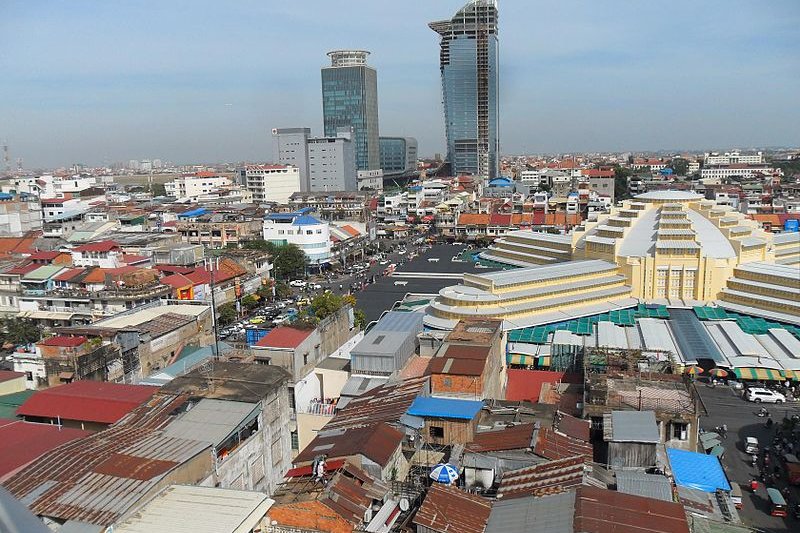 Modern Phnom Penh gets its share of skyscrapers. In the foreground is the restored Central Market
Modern Phnom Penh gets its share of skyscrapers. In the foreground is the restored Central MarketSource: https://commons.wikimedia.org/wiki/File:Phnom_Penh,.JPG
Author: Milei.vencel

Author: Milei.vencel

Phnom Penh is the terminus of the country's only two railroads - one extending to the Thai border and another to the deepwater port of Kompong Som on the Gulf of Thailand. There is an international airport in nearby Pochentong.
Phnom Penh is an ancient city that can trace its history to the 14th century, when Ponhea Yat, the Khmer king at that time, moved the capital from Angkor Thom to a settlement beside the Tonle Sap river. The population of Phnom Penh had fluctuated wildly in recent history.
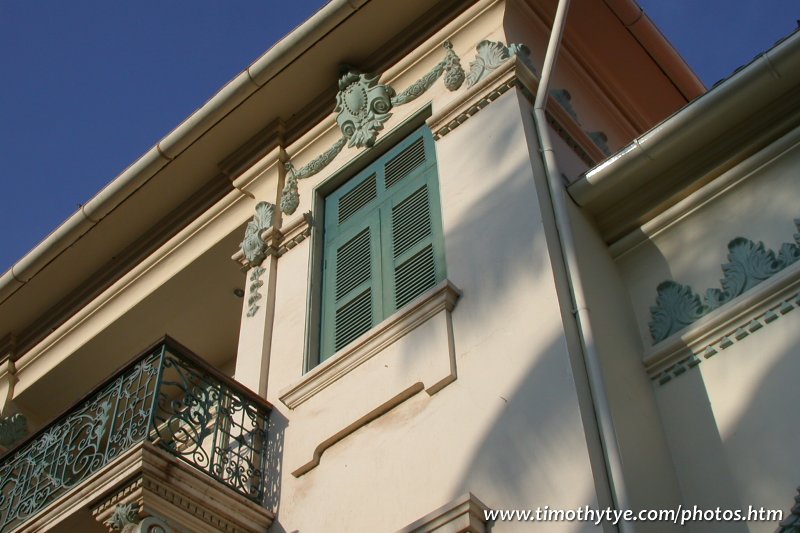 French colonial architecture in Phnom Penh (29 September, 2002)
French colonial architecture in Phnom Penh (29 September, 2002)
In 1975, it swelled to over 2 million people when refugees fleeing the fighting in the countryside flooded the capital. On 17 April of that year, Phnom Penh was taken by the Khmer Rouge forces, and the Khmer Rouge wasted no time in forcing all of Phnom Penh's residents out of the city, sending them to the countryside to work as forced labourers. For years, during the Khmer Rouge regime, Phnom Penh was a dead town.
Only after the Khmer Rouge were vanquished by Vietnamese forces did people return to Phnom Penh. By 1998, a census placed the population at 862,000. By 2001, the estimate was slightly over 1 million. It is believed that 2 million people may be living in and around Phnom Penh today.
Many tourists to Phnom Penh are surprised to find such a lovely city, with broad, leafy boulevards which were built by the French, against a distinctly Indochinese backdrop. It is not too big a city, and the main sights could well be covered on foot, while those further away will require you to hire your own transport or join a day tour.
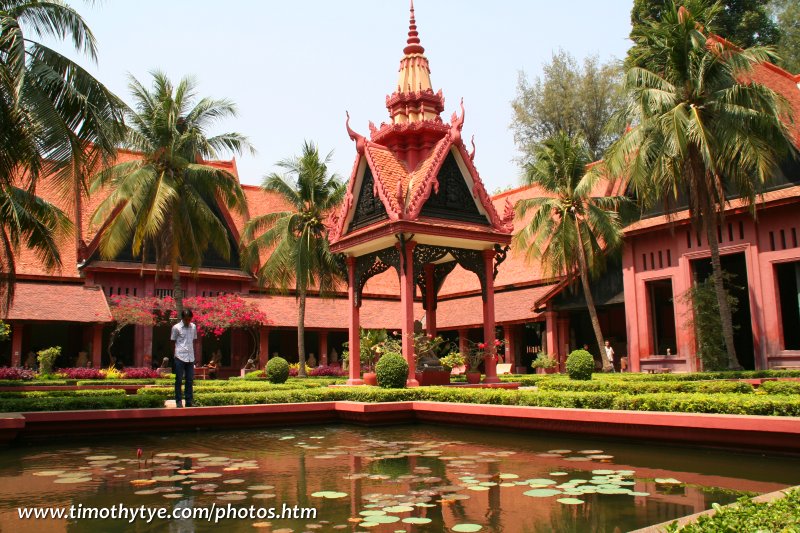 Phnom Penh National Museum courtyard (3 March, 2008)
Phnom Penh National Museum courtyard (3 March, 2008)
Major tourist sights in Phnom Penh are related to its recent history. Among these is the Tuol Sleng Genocide Museum and the Killing Fields. The Phnom Penh National Museum houses some of the finest collection of Angkorian art to be found anywhere in the world - indeed, this non air-conditioned museum is perhaps the only place to view original Angkorian sculptures, even in Angkor itself, the sculptures are often replaced by replicas to prevent theft. Scroll down to view list of sights in Phnom Penh.
Origin of the name Phnom Penh
Phnom Penh takes its name from Wat Phnom Daun Penh, which today is know as just Wat Phnom or Hill Temple. Wat Phnom was built in 1373 to house five statues of Buddha on a 27 meter high man-made hill. It was named after a wealthy widow by the name of Daun Penh or Grandma Penh.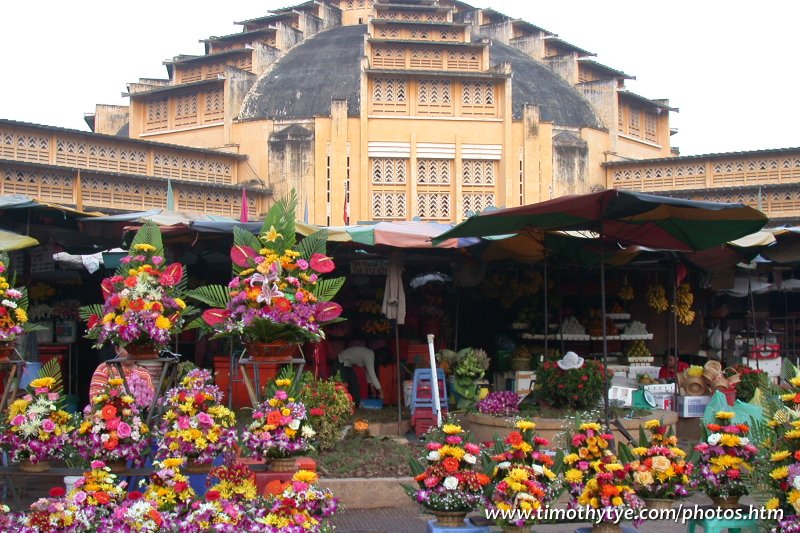 Phnom Penh Central Market (29 September, 2002)
Phnom Penh Central Market (29 September, 2002)
Phnom Penh was also previously known as Krong Chaktomuk which means "City of Four Faces". The "four faces" refers to the confluence of the Mekong, Bassac, and Tonle Sap rivers forming an "X" where the capital is situated. Krong Chaktomuk is itself an abbreviation of the ceremonial name given by King Ponhea Yat which was "Krong Chaktomuk Mongkol Sakal Kampuchea Thipadei Sereythor Inthabot Borei Roth Reach Seima Maha Nokor".
History of Phnom Penh
After repeated assault by the kingdom of Siam eroded its power, Ponhea Yat (1405-1467), the king of the Khmer Empire fled Angkor Thom in 1431 when the Siamese forces of Ayutthaya captured it. From Angkor, the capital was transferred to Phnom Penh, for a short period, in 1432. Then it moved to Lovek which was also attacked by the Siamese in 1594. The next site was Udong, which served as the Khmer capital on more than one occasion between 1618 and 1866, when the capital was finally moved to Phnom Penh. The stupa behind Wat Phnom houses the remains of Ponhea Yat and the royal family as well as the remaining Buddhist statues from the Angkorean era.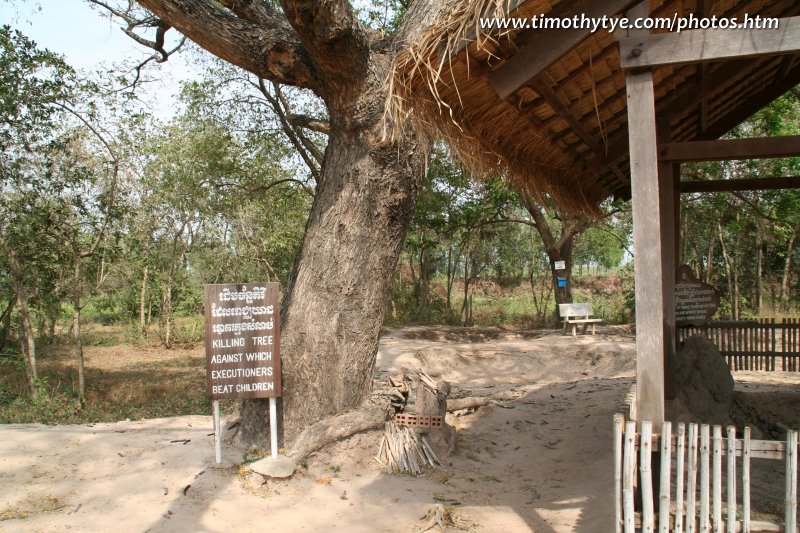 The Killing Tree, used to kill people at the Killing Fields (3 March 2008)
The Killing Tree, used to kill people at the Killing Fields (3 March 2008)
Phnom Penh only became the permanent seat of government in 1866, under the reign of King Norodom I, and the Phnom Penh Royal Palace was built. This marked the beginning of the transformation of Phnom Penh from a village into a great city.
The French Colonialists expanded the canal system to control the wetlands. They constructed roads and built a port. By the 1920s Phnom Penh was known as the Pearl of Asia and over the next four decades continued to experience growth with the building of a railway to Sihanoukville and the Pochentong International Airport.
During the Vietnam War, Cambodia was used as a base by the North Vietnamese Army and the Viet Cong, and thousands of refugees from across the country flooded the city to escape the fighting between their own government troops, the NVA/NLF, the South Vietnamese and its allies and the Khmer Rouge.
Phnom Penh suffered greatly during the civil war in the 1970s. The onset of fighting between government forces and the Khmer Rouge in 1970 drove refugees from the war-torn countryside into Phnom Penh, causing its population to increase from ca 500,000 in 1970 to ca. 2 million in early 1975. When the Khmer Rouge took the city, they evacuated the whole city, driving the population into the countryside to work as forced labourers. During that period, many of the intellectuals, from professionals like doctors and lawyers to teachers, were brutally killed.
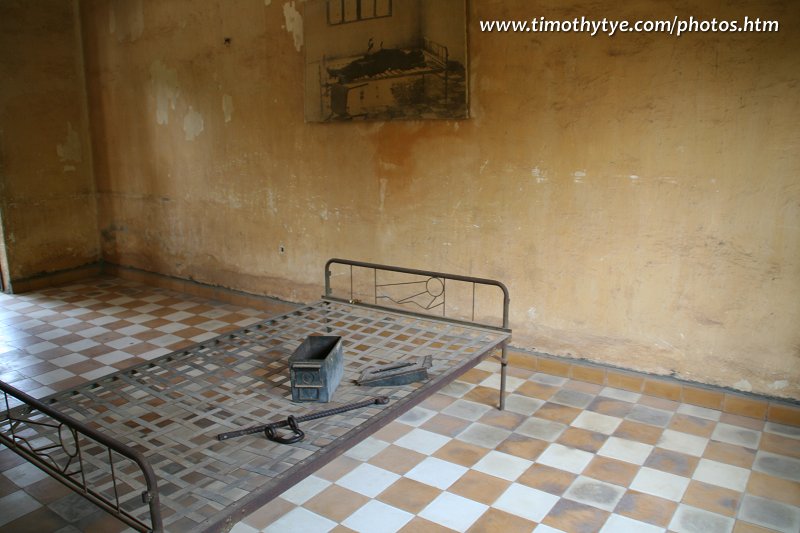 Bed of torture, Tuol Sleng Genocide Museum (3 March 2008)
Bed of torture, Tuol Sleng Genocide Museum (3 March 2008)
Phnom Penh was taken by the Khmer Rouge and Democratic Kampuchea on April 17, 1975, the Cambodian New Year, and was evacuated by force. Its residents being made to work as forced labourers in rural farms. They were called "new people". Tuol Svay Prey High School was taken over by Pol Pot's forces and was turned into the S-21 prison camp, where Cambodians were detained and tortured. It is now the Tuol Sleng Museum and along with Choeung Ek (The Killing Fields), 15 kilometers away, a memorial to those who were killed by the regime.
By the time the Khmer Rouge were overthrown in 1979, the city had become virtually a ghost town, with no more than 50,000 residents and its universities and cultural institutions no longer in operation. It gradually revived through the 1980s, spurred by continuing stability of government, attracting new foreign investment and aid by countries including France, Australia, and Japan. Loans were made from the Asia Development Bank and the World Bank to reinstate a clean water supply, roads and other infrastructure. By 1998, Phnom Penh's population was 862,000.
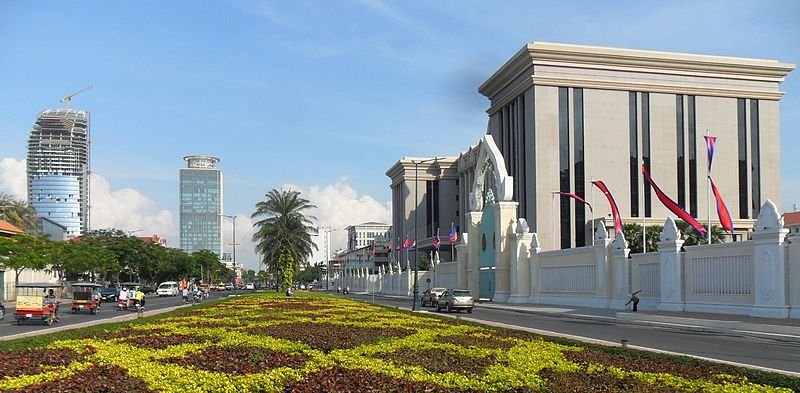 Russian Boulevard, Phnom Penh
Russian Boulevard, Phnom PenhSource: https://commons.wikimedia.org/wiki/File:Russian_Blvd,_P.P..JPG
Author: Milei.vencel

Author: Milei.vencel

Arriving in Phnom Penh
The majority of visitors arrive by air, at the Phnom Penh International Airport. Some arrive by ferry from Siem Reap and Ho Chi Minh City, and still some by coach from Thailand.By Air
Phnom Penh International Airport, formerly Pochentong International Airport, is the main gateway into Cambodia.It is located 11km from the city centre (Sisowath Quay). Taxi is available outside the Arrival Hall. Taxi from airport to city is between US$5 and US$7. It takes about 20 minutes to go from Phnom Penh International Airport to the city. Motodop (motorcycle taxi) available around US$2. Always negotiate and agree on the fare before the ride. You can take the official airport taxi by buying a coupon at the airport taxi counter for US$7. If you have your accommodation booked in advance, check whether transfer from airport to hotel is provided.
Budget airlines that fly to Phnom Penh includes AirAsia and Jetstar Asia.
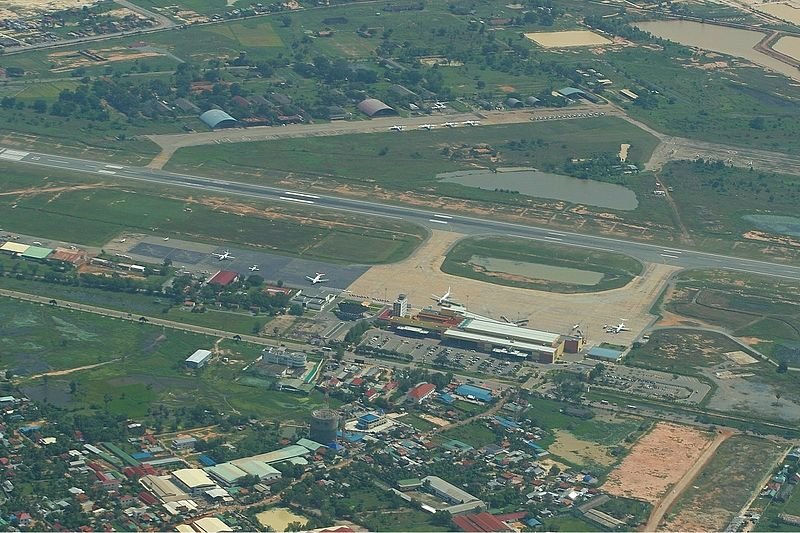 Pochentong International Airport, Phnom Penh
Pochentong International Airport, Phnom PenhSource: https://commons.wikimedia.org/wiki/File:Pochentong_International_Airport_aerial_overview_MRD.jpg
Author: M Radzi Desa

Author: M Radzi Desa

Airport Tax:
International departures from Phnom Penh: US$25 for adults, US$13 for children 12 and under.
Domestic departure: US$6
Getting to Phnom Penh by Road
From Thailand: Bus available from Poipet, on the Thai border.Fare to Thailand is about US$10. Journey between Poipet and Phnom Penh is about 12 hours.From Vietnam: Bus available from Ho Chi Minh City. May is about 5-6 hours between Ho Chi Minh City and Phnom Penh.
Travel Advice We urge travellers entering Phnom Penh to take the flight. Those entering by road are often exposed to border scams. Get your visa ready or else you may face border officials who create their own border laws, charging you inflated price for visa, or charging you a fee for vaccination certs that are not mandatory.
Bus Companies
Take the bus as the rather chaotic "terminal" at the southwest corner of the Central Market.
Sorya (Ho Wah Genting)
Corner Street 217 and street 67, Phnom Penh 12209 Cambodia.
Tel: (855) 23 210-359, 210-859
GST Express Bus
#13 Street 142, Phnom Penh 12209 Cambodia.
Mobile: (855) 12 838-910, 12 895-550
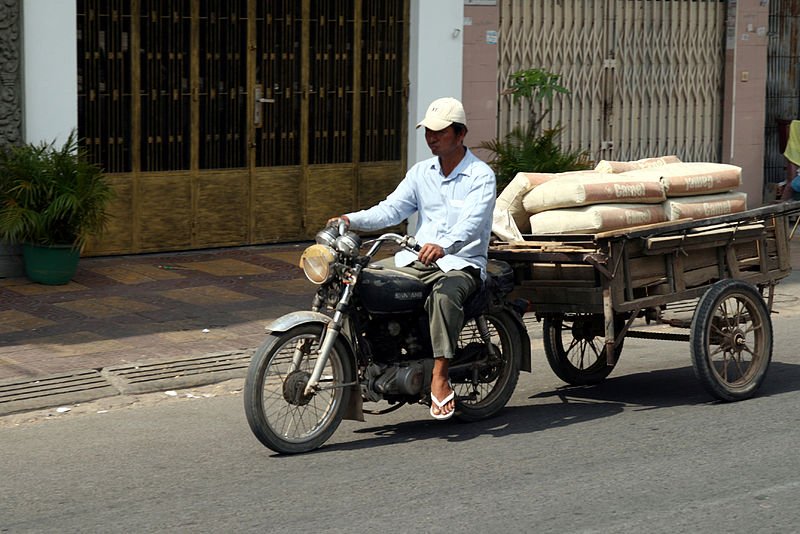 Motorcycle transporting goods in Phnom Penh
Motorcycle transporting goods in Phnom PenhSource: https://commons.wikimedia.org/wiki/File:Phnom_Pen_-_Cycle_(4).JPG
Author: Remi Jouan

Author: Remi Jouan

Getting to Phnom Penh by Boat
From Siem Reap: Visitors to the ruins of Angkor at Siem Reap may consider taking a ferry to Phnom Penh. The journey can be as short as 5 hours and as long as hours, depending on the speed of the boat and the depth of the water. Along the journey, you get a glimpse of rural Cambodia, and life along this main artery. Ticket price is about US$25 - you may get it cheaper if buying from a tour agency.From Vietnam: Fast boat journey between Chau Doc on the Mekong delta, in Vietnam, and Phnom Penh. The journey takes about 5 hours. Boat leaves Chau Doc at 8:00am in the morning, and leaves Phnom Penh at 1:00pm in the afternoon, arriving in Chau Doc in the evening.
Boat Operators
Khemara Express Boat: High Way No 5A In Front of Soksan Club: Tel: 023 430 777
Soon Ly Boat: Tel: 023 725 797/ 012 728 055
Channa Boat: Tel: 023 725 788
Royal Express Boat: Sangkat Sras Chork Khan Daun Penh, Road No 5. Tel: 023 725 538
Angkor Express Boat: Sisowath Squay International Phnom Penh Port. Tel: 023 426 892
Rambo Express Boat: Tel: 012 846 818/ 011 876 678
Mittapheap Boat (Friendship): Tel: 023 880 857/011 876 555
Hang Chau Boat: Sisowath Squay International Phnom Penh Port. Tel: 012 883 542
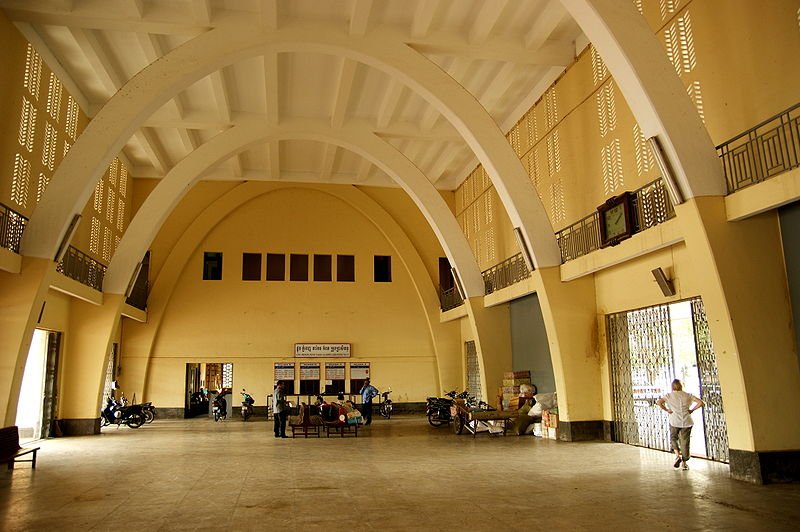 Phnom Penh Railway Station
Phnom Penh Railway StationSource: https://commons.wikimedia.org/wiki/File:2009-09-07_09-09_Phnom_Penh_036_Train_Station.jpg
Author: Allie Caulfield

Author: Allie Caulfield

Getting to Phnom Penh by Train
If you have time to kill, there's a train service between Phnom Penh and Battambang, the second largest city in Cambodia. The journey is scheduled to take 14 hours, but usually takes much, much longer, although the journey is only 275km. The ticket is only 22,500 riel per way for foreigners. Train leaves Phnom Penh at 6:20am on Saturdays, and return trip leaves Battambang at 6:40am.Telecommunications in Phnom Penh
When dialling from overseas, the IDD code for Cambodia is 855. The area code for Phnom Penh is 23. When dialing within the country outside the same area code, add 0 in front of the 23.Emergency Contacts in Phnom Penh
Phnom Penh, a much larger city than Siem Reap, is regarded as having a higher crime rate.Ambulance: 119 or (23) 724891
Police: 112, 117 and 012-999999
Fire: 118
Police for Foreigners: (23) 724793
Hospital
Calmette Hospital, 3 Monivong, tel: (23) 426948
International SOS Medical & Dental Clinic, #161 Street 51, tel: (23) 216911
Naga Clinic, #11 Street 254, tel: (011-811175
Tropical & Travellers Medical Clinic, #88, Street 108, tel: (23) 366802 / 012-898981
Dentist
German Dental Clinic, #9A Street 594, Toul Kok, tel: 012-894679, 018-811893
IMI, #193 Street 208, tel: (23) 212909, 016-880873
Roomchang Dental Clinic, #58 Street 228, tel: (23) 211338
Opticians
I Care Optical Centre, #166, Norodom, tel: (23) 215778
Royal Optic, #220, Monivong, tel: (23) 428280
Pharmacies
Pharmacy De La Gare, #81Eo, Monivong, tel: (23) 526855
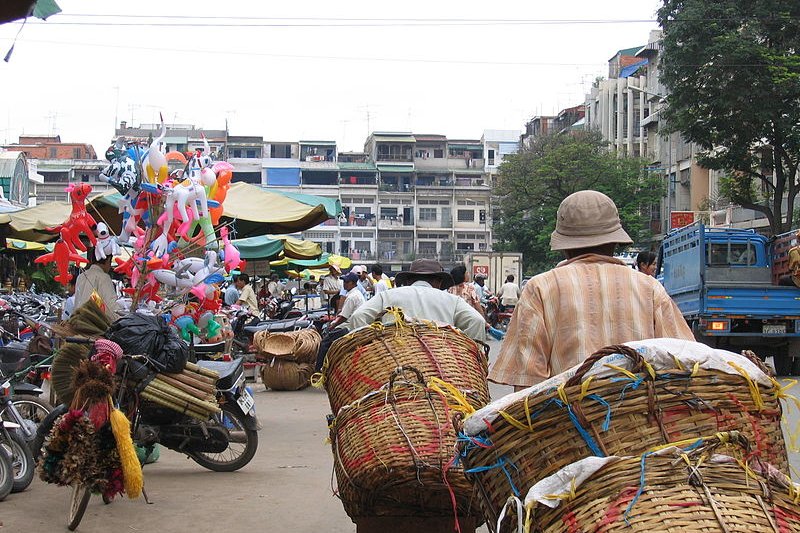 Phnom Penh street scene
Phnom Penh street sceneSource: https://commons.wikimedia.org/wiki/File:OrussetMarket_Phnom_Penh_2005_2.JPG
Author: Sundgauvien38

Author: Sundgauvien38

Getting Around Phnom Penh
Apart from walking, you can take a number of transports to take you around Phnom Penh. There are no buses though. I arrange the list below according to what I find most convenient to an average tourist:Taxi Vantha, tel: 023 993 433, email info@taxivantha.com, web: www.taxivantha.com Sovan Transportation, tel: 012 842 393, email 012842393@mobitel.com.kh Chettra Taxi, tel: 016 312 474, 011 655 240, email chettrataxi@yahoo.com Khmer Taxi, tel: 012 511 105, 011 957 099, email sarithkasath@yahoo.com Phnom Penh Taxi, tel: 016 886 544, email benweekh@yahoo.com
Car Rental Co Ltd
No 49, Street 592
12152 Phnom Penh
Tel: 023 880 001
email: car_rental@online.com.kh
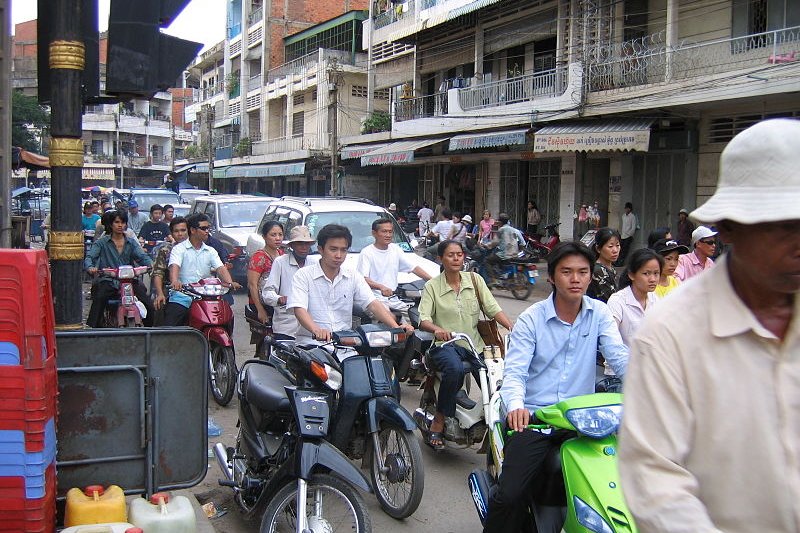 A street in Phnom Penh
A street in Phnom PenhSource: https://commons.wikimedia.org/wiki/File:TrafficJam_PhnomPenh_2005_2.JPG
Author: Sundgauvien38

Author: Sundgauvien38

Postal Services
Main Post OfficeThe main post office of Phnom Penh is located on Street 13, a short distance from Wat Phnom.
Courier Services
DHL, #28 Monivong, tel: (23) 427726FedEx, #701D, Monivong, tel: (23) 216712
TNT, #151F Street 154, tel: (23) 211880
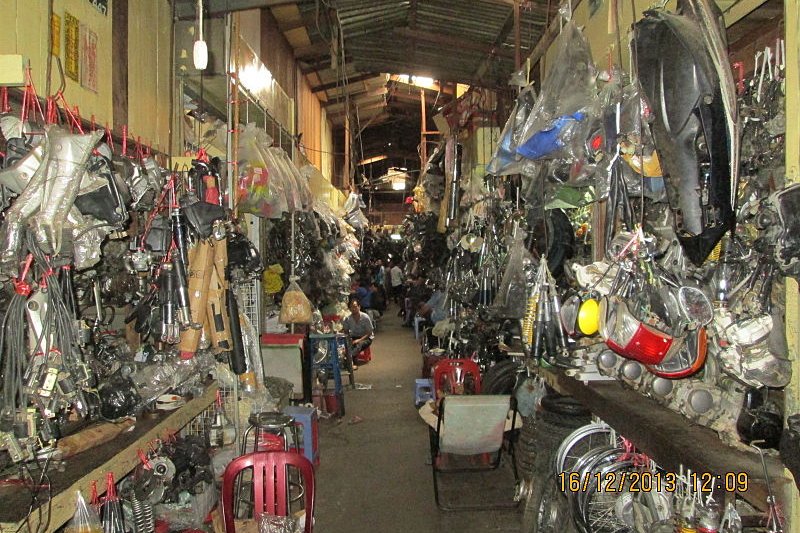 Motorcycle parts on sale at the Russian Market in Phnom Penh
Motorcycle parts on sale at the Russian Market in Phnom PenhSource: https://commons.wikimedia.org/wiki/File:World%27s_best_motorcycle_spare_parts_in_%27Russian_Marke%27.JPG
Author: Rudolph A. Furtado

Author: Rudolph A. Furtado

Shopping in Phnom Penh
Phnom Penh is not regarded as a big shopping destination, unless your shopping list includes pirated copies travel guides (photocopied pages with reprinted covers) and fake branded items. If that's what you're looking for, head for the Phnom Penh Central Market. This art-deco building, constructed in the 1930's by the French, is called Psar Thei, meaning New Market. This is the place to view a day in the life of Phnom Penh. Sold here include fresh flowers, jewellery, school books, photocopied travel guides, and fake branded clothes.Another touristic shopping place is the Russian Market. There is nothing Russian about this place except its name, which it earned during the 1980s Vietnamese occupation. The locals call it Psar Toul Tom Poung. This is a bit like a big hardware market, with stalls selling metal items, including fake Swiss watches, clocks and pirated software.
Souvenirs
The souvenir most representative of Cambodia would be the krama, the checkered scarf used by both men and women to keep out dust and sun. These are quite inexpensive, and more so if you have good bargaining skills. Other popular souvenirs include:
- Silver Boxes. These are not cheap, but make exquisite display items. These intricate silver containers were used to keep betel leaf.
- Silk Items. Depending on where you buy them, the silk could either be machine produced or traditionally hand woven. Look for shops selling silk items in the Central Market and Russian Market.
- Gems. Travel Advice Unless you really know your gems, my advise is to stay away from spending a small fortune on stones of dubious authenticity.
- Sculpture. The serene head of Jayavarman VII, famous Angkor king from the 13th century, is a popular souvenir carved in stone. The second most popular sculpture is replicas of the Leper King from the Terrace of the Leper King in Angkor.
- Basketware. You can get them from the Central Market, but for more exquisite examples (with an expected more exquisite price), visit Baskets of Cambodia, www.basketsofcambodia.com
If you are looking for high-quality traditional items, check out the following outlets:
- Apsara Art Gallery: #170A, Street 450, Tel: 012-867390
Shop specialising in contemporary Southeast Asian art. - Asasax Art Gallery: #192, Street 178, Tel: 012-363030
Located near the Royal Palace, this is the gallery of well-known Cambodian artist, Asasax - Bazar, art de vivre: #28, Sihanouk; email mai_ioa@yahoo.com
Specialty shop for home decorative items, furniture, textile and lighting. - Couleurs d'Asie: #19, Street 360, Phnom Penh, Tel: 012-902650, info@couleursdasie.net
Boutique specialising in home decor, silk, curios and Asian furniture. - Tabitha Cambodia
Cambodian silk products
Shows & Performances
After the Khmer Rouge clamp down on traditional arts, cultural shows are only now beginning a quiet recovery. Rather surprisingly, it is still not easy to find regular cultural performances in Phnom Penh (not the case in Siem Reap, though). Check out the following venues for possibilities:- Phnom Penh Cultural Center, pp_cc@online.com.kh phone: (855 23) 883 050 | Mobile: (855 12) 399 985, (855 12) 919 020
- Souvanna Phum Theatre: 111 Street 360, corner Street 105 (tel: (023) 987 564)
Performances of traditional dance, music and shadow puppetry on most Friday and Saturday evenings. - Chatomuk Theatre: Sisowath Quay (tel: (023) 725 119)
Occasional performances of traditional music and dance.
Tourist Attractions
In this section, I list out the sights in and around Phnom Penh, and provide a brief description for you to determine whether or not they are worth visiting. Some sights are hyperlinked to their own pages where you find more detailed description and original photographs.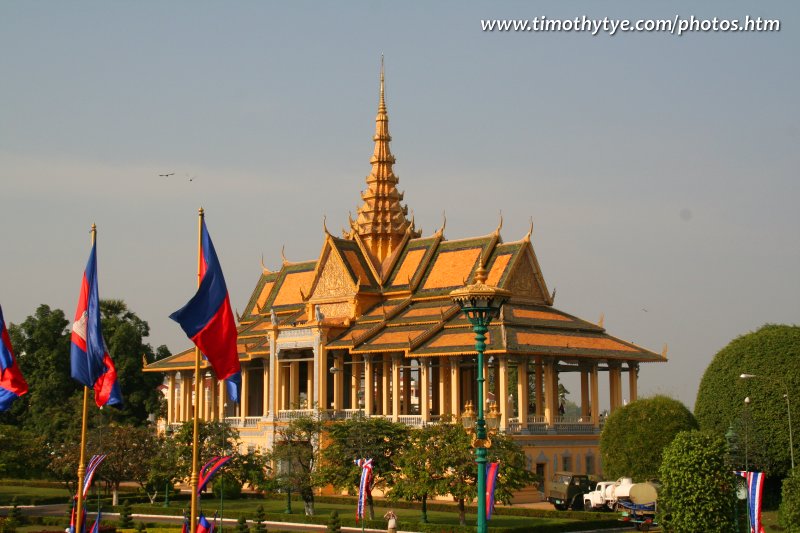 The Chan Chaya Pavilion at the Royal Palace of Phnom Penh (3 March 2008)
The Chan Chaya Pavilion at the Royal Palace of Phnom Penh (3 March 2008)
 Latest updates on Penang Travel Tips
Latest updates on Penang Travel Tips
 Map of Roads in Penang
Map of Roads in Penang
Looking for information on Penang? Use this Map of Roads in Penang to zoom in on information about Penang, brought to you road by road.
Copyright © 2003-2025 Timothy Tye. All Rights Reserved.

 Go Back
Go Back